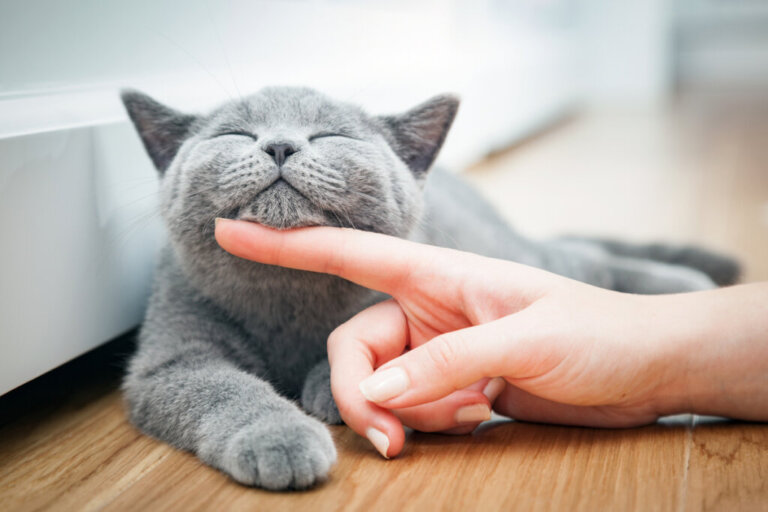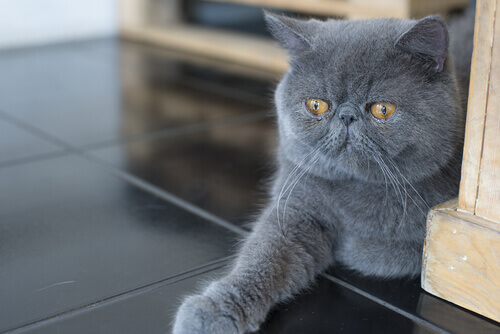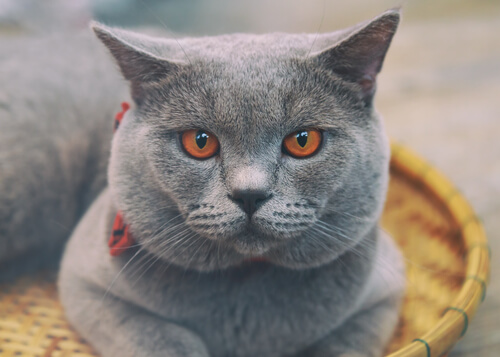11 Gray Cat Breeds

There are several gray cat breeds that have become popular around the world and, although each one has different qualities and personalities, they all share the fact that they’re peculiar, as a gray cat never goes unnoticed.
At first glance, some may look very similar, but the truth is that each one has a different behavior. That’s why, below, we’ll describe seven different breeds of gray cats that you surely didn’t know about. Take note!
Gray cat breeds
Within the gray cat breeds, there are some that can have blue eyes, others with brindle fur, and there are also those with blue-gray fur. Keep reading and get to know them in detail.
1. The Gray Persian
There are many variations of the Persian cat in terms of shade, size, and eye color. Gray Persian cats are descended from the Angora cat, a very old Turkish breed.
As for their physique, they look obese, but it doesn’t mean that they are; it’s because they’re robust and muscular. In addition, their fur is thick and fluffy, which adds more volume; their head is rounded and their face is a little more flattened than that of the common feline.
At the same time, the personality of the gray Persian cat is very calm. It tends to be a quiet, affectionate, and cuddle-loving pet.

2. The Turkish Angora
Being native to Turkey, the great majority of Turkish Angoras have white fur, but there are also gray fur cats. In any case, their coat is silky, fine, and very soft. What’s more, it has the particularity of being more abundant in the areas of the neck and tail. In addition, other very specific characteristics are that they have longer ears than the common cat and that their hind legs are higher than the front legs.
Generally, it’s one of the healthiest breeds of gray cats because it’s very rare for this breed to contract diseases. Nevertheless, it’s important to take good care of them so that they live for a long time.
3. The Egyptian Mau
As its name suggests, the Egyptian mau comes from Egypt, where ancient people worshipped these animals for thousands of years. In fact, the term “mau” comes from the native Egyptian language and the exact translation is “cat.”
Physically, these green-eyed felines have a very particular coat full of dark stripes, inherited from the small African wild cat. However, in some cats of this breed, the spots can be brown or bluish over gray.
On the other hand, unlike the previous gray cat breeds, this is one of the most intelligent, independent, territorial, and possessive. They’re only friendly and affectionate with the people in their family nucleus.
4. The American shorthair
This is one of the most popular cats in homes around the world, due to its sociable and very friendly personality. They’re very intelligent and agile cats, which increases their attractiveness as pets.
As for their physique, they have a small nose on a wide and round head, and they have the particularity of having what appears to be a letter M on their forehead. They can weigh up to thirteen pounds, so their size is medium to large. Their coat is short, but the color can vary in almost any shade, the most common being a mixture of silver with dark stripes along the body.
5. Nebelung
Just as the crossing of canine breeds generates beautiful specimens, the same happens with cats. Such is the case of the Nebelung cat, the result of a longhair mother and a Russian blue father.
The Nebelung cat inherited an impressive physique, being strong, muscular, and robust, with a long blue-gray coat, which must be brushed frequently in order to keep it healthy and free of impurities. It also has very expressive eyes, which are usually yellow or green in color.
At first glance, they seem to be a quiet breed, but once they feel at ease in their environment, they’re quite curious and mischievous, so naturally, they’re also very playful and sociable.
6. The Russian blue
Because of where they originate from (northern Russia), Russian blues are a rather privileged breed of gray cats. Their coat is thick and dense to protect them from cold climates. In addition, they weigh up to eleven pounds and easily reach fifteen years of life.
Generally, cats of this breed have blue-green eyes, although when they’re newborns, their eyes are completely blue until, as they grow up, the color varies. However, what’s most striking is their gray coat, which tends to look bluish.
As far as their personality is concerned, Russian Blues are a very calm and even timid breed with people they’ve just met. On the other hand, with their caregivers, they tend to be very attached and affectionate, as well as playful. Perhaps their most recurrent way of showing this is to bring things to their owners.
7. Chartreux

Originally from France and like the previous breed, this cat is robust, muscular, and has developed a prominent blue-gray coat to withstand the cold. It’s a rather striking cat, with eyes in intense tones such as yellow, green, or copper.
The personality of this cat is very sociable, friendly, and playful. It’s ideal for people who live alone and love the company of house cats.
Originally, it was actively bred by monks, and then it was popularized in the United Kingdom and elsewhere in Europe. It almost became extinct during World War II, but managed to linger on for a long time.
These are some of the gray cat breeds that impress us with their peculiarities. Which one is your favorite?
There are several gray cat breeds that have become popular around the world and, although each one has different qualities and personalities, they all share the fact that they’re peculiar, as a gray cat never goes unnoticed.
At first glance, some may look very similar, but the truth is that each one has a different behavior. That’s why, below, we’ll describe seven different breeds of gray cats that you surely didn’t know about. Take note!
Gray cat breeds
Within the gray cat breeds, there are some that can have blue eyes, others with brindle fur, and there are also those with blue-gray fur. Keep reading and get to know them in detail.
1. The Gray Persian
There are many variations of the Persian cat in terms of shade, size, and eye color. Gray Persian cats are descended from the Angora cat, a very old Turkish breed.
As for their physique, they look obese, but it doesn’t mean that they are; it’s because they’re robust and muscular. In addition, their fur is thick and fluffy, which adds more volume; their head is rounded and their face is a little more flattened than that of the common feline.
At the same time, the personality of the gray Persian cat is very calm. It tends to be a quiet, affectionate, and cuddle-loving pet.

2. The Turkish Angora
Being native to Turkey, the great majority of Turkish Angoras have white fur, but there are also gray fur cats. In any case, their coat is silky, fine, and very soft. What’s more, it has the particularity of being more abundant in the areas of the neck and tail. In addition, other very specific characteristics are that they have longer ears than the common cat and that their hind legs are higher than the front legs.
Generally, it’s one of the healthiest breeds of gray cats because it’s very rare for this breed to contract diseases. Nevertheless, it’s important to take good care of them so that they live for a long time.
3. The Egyptian Mau
As its name suggests, the Egyptian mau comes from Egypt, where ancient people worshipped these animals for thousands of years. In fact, the term “mau” comes from the native Egyptian language and the exact translation is “cat.”
Physically, these green-eyed felines have a very particular coat full of dark stripes, inherited from the small African wild cat. However, in some cats of this breed, the spots can be brown or bluish over gray.
On the other hand, unlike the previous gray cat breeds, this is one of the most intelligent, independent, territorial, and possessive. They’re only friendly and affectionate with the people in their family nucleus.
4. The American shorthair
This is one of the most popular cats in homes around the world, due to its sociable and very friendly personality. They’re very intelligent and agile cats, which increases their attractiveness as pets.
As for their physique, they have a small nose on a wide and round head, and they have the particularity of having what appears to be a letter M on their forehead. They can weigh up to thirteen pounds, so their size is medium to large. Their coat is short, but the color can vary in almost any shade, the most common being a mixture of silver with dark stripes along the body.
5. Nebelung
Just as the crossing of canine breeds generates beautiful specimens, the same happens with cats. Such is the case of the Nebelung cat, the result of a longhair mother and a Russian blue father.
The Nebelung cat inherited an impressive physique, being strong, muscular, and robust, with a long blue-gray coat, which must be brushed frequently in order to keep it healthy and free of impurities. It also has very expressive eyes, which are usually yellow or green in color.
At first glance, they seem to be a quiet breed, but once they feel at ease in their environment, they’re quite curious and mischievous, so naturally, they’re also very playful and sociable.
6. The Russian blue
Because of where they originate from (northern Russia), Russian blues are a rather privileged breed of gray cats. Their coat is thick and dense to protect them from cold climates. In addition, they weigh up to eleven pounds and easily reach fifteen years of life.
Generally, cats of this breed have blue-green eyes, although when they’re newborns, their eyes are completely blue until, as they grow up, the color varies. However, what’s most striking is their gray coat, which tends to look bluish.
As far as their personality is concerned, Russian Blues are a very calm and even timid breed with people they’ve just met. On the other hand, with their caregivers, they tend to be very attached and affectionate, as well as playful. Perhaps their most recurrent way of showing this is to bring things to their owners.
7. Chartreux

Originally from France and like the previous breed, this cat is robust, muscular, and has developed a prominent blue-gray coat to withstand the cold. It’s a rather striking cat, with eyes in intense tones such as yellow, green, or copper.
The personality of this cat is very sociable, friendly, and playful. It’s ideal for people who live alone and love the company of house cats.
Originally, it was actively bred by monks, and then it was popularized in the United Kingdom and elsewhere in Europe. It almost became extinct during World War II, but managed to linger on for a long time.
These are some of the gray cat breeds that impress us with their peculiarities. Which one is your favorite?
All cited sources were thoroughly reviewed by our team to ensure their quality, reliability, currency, and validity. The bibliography of this article was considered reliable and of academic or scientific accuracy.
- Emily, W. (s. f.). Nebelung Cat Facts. ASPCA Pet Health Insurance. Consultado el 16 de agosto de 2023.
https://www.aspcapetinsurance.com/resources/nebelung-cat-facts/ - Godiksen, M. T., Granstrøm, S., Koch, J., & Christiansen, M. (2011). Hypertrophic cardiomyopathy in young Maine Coon cats caused by the p.A31P cMyBP-C mutation–the clinical significance of having the mutation. Acta veterinaria Scandinavica, 53(1), 7. https://pubmed.ncbi.nlm.nih.gov/21306647/
- VCA Animal Hospitals. (s. f.). American Shorthair. Consultado el 16 de agosto de 2023. https://vcahospitals.com/know-your-pet/cat-breeds/american-shorthair
- VCA Animal Hospitals. (s. f.). Persian. Consultado el 16 de agosto de 2023. https://vcahospitals.com/know-your-pet/cat-breeds/persian
- VCA Animal Hospitals. (s. f.). Scottish Fold. Consultado el 16 de agosto de 2023. https://vcahospitals.com/know-your-pet/cat-breeds/scottish-fold
- VCA Animal Hospitals. (s. f.). Korat. Consultado el 16 de agosto de 2023. https://vcahospitals.com/know-your-pet/cat-breeds/korat
- VCA Animal Hospitals. (s. f.). Turkish Angora. Consultado el 16 de agosto de 2023. https://vcahospitals.com/know-your-pet/cat-breeds/turkish-angora
- VCA Animal Hospitals. (s. f.). Maine Coon. Consultado el 16 de agosto de 2023. https://vcahospitals.com/know-your-pet/cat-breeds/maine-coon
- VCA Animal Hospitals. (s. f.). British Shorthair. Consultado el 16 de agosto de 2023. https://vcahospitals.com/know-your-pet/cat-breeds/british-shorthair
- VCA Animal Hospitals. (s. f.). Chartreux. Consultado el 16 de agosto de 2023. https://vcahospitals.com/know-your-pet/cat-breeds/chartreux
- VCA Animal Hospitals. (s. f.). Russian Blue. Consultado el 16 de agosto de 2023. https://vcahospitals.com/know-your-pet/cat-breeds/russian-blue
- VCA Animal Hospitals. (s. f.). Egyptian Mau. Consultado el 16 de agosto de 2023. https://vcahospitals.com/know-your-pet/cat-breeds/egyptian-mau
This text is provided for informational purposes only and does not replace consultation with a professional. If in doubt, consult your specialist.








